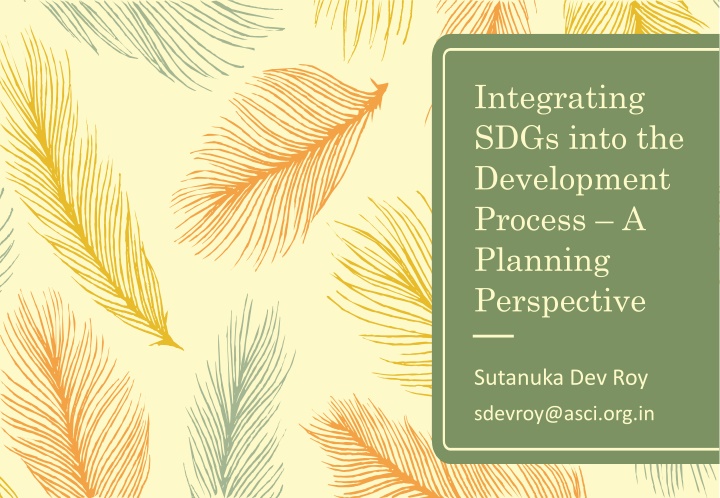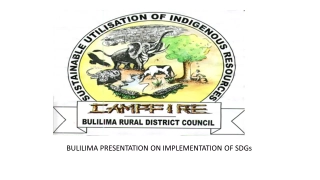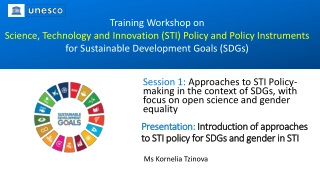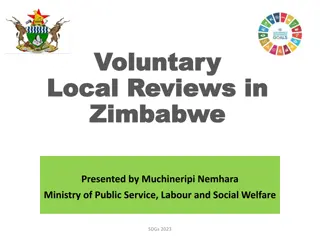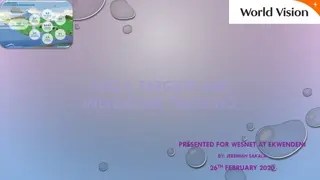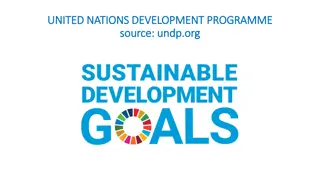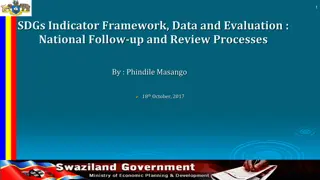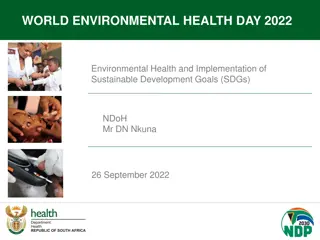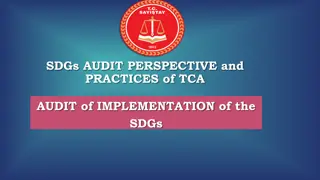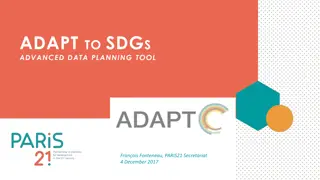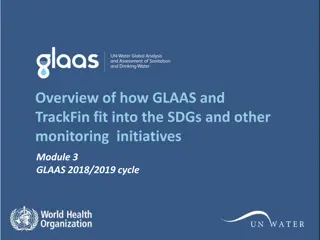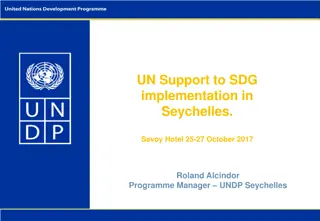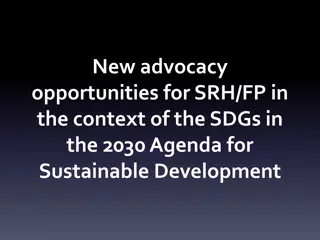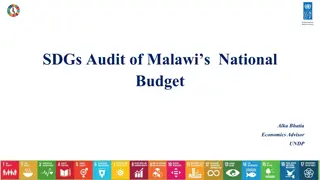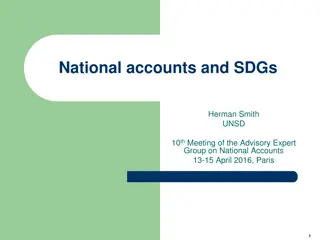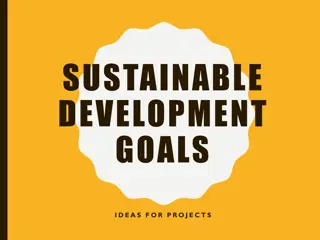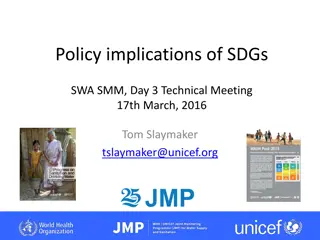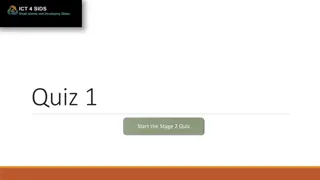Integrating SDGs into the Development Process: A Planning Perspective
In economics, economic growth and development have distinct meanings. Growth pertains to the size of the economy measured by GDP, while development involves structural and social changes linked with growth, focusing on improving human well-being in addition to income growth. Various processes in economic development encompass industrial, social, cultural, and political transformations. Additionally, traditional theories and global initiatives contribute to understanding and achieving economic development goals.
Download Presentation

Please find below an Image/Link to download the presentation.
The content on the website is provided AS IS for your information and personal use only. It may not be sold, licensed, or shared on other websites without obtaining consent from the author.If you encounter any issues during the download, it is possible that the publisher has removed the file from their server.
You are allowed to download the files provided on this website for personal or commercial use, subject to the condition that they are used lawfully. All files are the property of their respective owners.
The content on the website is provided AS IS for your information and personal use only. It may not be sold, licensed, or shared on other websites without obtaining consent from the author.
E N D
Presentation Transcript
Integrating SDGs into the Development Process A Planning Perspective Sutanuka Dev Roy sdevroy@asci.org.in
Economic Growth versus Economic Development In economics, the term economic growth and economic development are distinctively used. Economic growth is the growth in the size of the real economy, which is measured by the gross domestic product (GDP). The growth rate is known as the economic growth rate. On the other hand, economic development is considered as a process. It involves structural changes and social transformation that accompany economic growth. Hence development is an outcome based concept it is said to occur only when human well-being has improved along with economic growth (income growth).
Processes in Economic Development Industrial transformation involves shift from a society that is agriculture-dominant to a society that is industry-dominant; and structural changes in the economy in the form of developments in economic/social infrastructure and institutions; Social transformation - the changes in lifestyles that accompany urbanization (labor migration from rural areas to cities); Cultural transformation indicates the shift from family/relative/ tribe-oriented organization/relationship to a more merit-based, contractual organization/ relationship; Political transformation - includes democratization and (legal) institution building for the establishment of property rights, contract enforcement.
Some Traditional Theories of Economic Development Most of the popular models of development are based on structural transformation. Development is breaking Nurkse's "vicious circle of poverty via Rosenstein-Rodan's "big push" and through "balanced growth" that would establish complementarity in demand, achieve Leibenstein's "critical minimum effort , break out of the "low-level equilibrium trap," and fulfill the conditions of Rostow's "takeoff."
Global Initiatives for Attaining Economic Development Millennium Development Goals (MDGs) - which started a global effort in 2000 to tackle the indignity of poverty. Key MDG achievement 1) More than 1 billion people have been lifted out of extreme poverty (since 1990) 2) Child mortality dropped by more than half (since 1990) 3) The number of out of school children has dropped by more than half (since 1990) 4) HIV/AIDS infections fell by almost 40 percent (since 2000) The legacy and achievements of the MDGs were valuable, but for millions of people around the world the job remained unfinished. The SDGs looked to finish what the MDGs started and also to shift the world onto a more sustainable path.
Sustainable Development Goals The Sustainable Development Goals (SDGs) were born at the United Nations Conference on Sustainable Development in Rio de Janeiro in 2012. The objective was to produce a set of universal goals that meet the urgent environmental, political and economic challenges facing our world. The SDGs are a bold commitment to finish what we started, and tackle some of the more pressing challenges facing the world today. All 17 Goals interconnect, meaning success in one affects success for others. Dealing with the threat of climate change impacts how we manage our fragile natural resources, achieving gender equality or better health helps eradicate poverty, and fostering peace and inclusive societies will reduce inequalities and help economies prosper.
SDGs The SDGs coincided with another historic agreement reached in 2015 at the COP21 Paris Climate Conference. Together with the Sendai Framework for Disaster Risk Reduction, signed in Japan in March 2015, these agreements provide a set of common standards and achievable targets to reduce carbon emissions, manage the risks of climate change and natural disasters, and to build back better after a crisis. The SDGs are unique in that they cover issues that affect us all. They reaffirm our commitment to end poverty, permanently, everywhere and make sure no one is left behind. More importantly, they involve us all to build a more sustainable, safer, more prosperous planet for all humanity.
Focus of the SDGs Sustainable Development that leaves no one behind The 2030 Agenda needs an integrated approach that tackles the connected issues of multidimensional poverty, inequality and exclusion, while enhancing skills and production technologies to enlarge peoples choices, reduce risks and sustain development gains. Livelihood and enough jobs must be created for economic recovery of migrants. Democratic Governance and Peace Building The 2030 Agenda features for the first time a universally agreed goal for achieving peaceful, just and inclusive societies through: conflict prevention, inclusive political process, responsive and accountable institutions, establishment of rule of law, justice, security and human rights, empowerment of youth, fighting corruption and prevention of violent extremism.
Focus of the SDGs Climate and Disaster Resilience To achieve the Sustainable Development Goals (SDGs) and eradicate poverty and inequality, tackling the dual threats of climate change and disasters is essential. By building resilience and ensuring that all development is risk-informed, countries and communities can protect against losses and simultaneously boost economic growth, create jobs and livelihoods, strengthen access to health and education.
Integration in SDGs The 2030 Agenda for Sustainable Development is often referred to as an integrated agenda and is frequently described as an indivisible whole . What does this mean in practice? 1) The pillars of SDGs - economic development, social development and environmental protection are intertwined, cutting across the entire Agenda. While most of the 17 SDGs have a clear starting point in one of the three pillars, most actually embed all three dimensions within their targets. Eg: SDG2 - End hunger, achieve food security and improved nutrition and promote sustainable agriculture contains targets with social (e.g. malnutrition and vulnerability), economic (e.g. agricultural productivity and agricultural trade) and environmental dimensions (e.g. genetic diversity and climate resilience)
Integration in SDGs 2) There are significant interactions between the SDGs themselves. Eg: Water is required in the energy sector for cooling in thermal power plants and for generating hydro-electricity; energy is required for residential and industrial water usage, and for pumping water for irrigation; and water is needed for all food and bioenergy production. 3) Because of the strength of these linkages, achieving targets under these goals can lead to trade-offs between competing interests. Eg: food production may compete with bioenergy production for the same land or water.
Integration in SDGs 4) The SDGs interact with a much broader set of targets and goals. Eg: SDG2 interacts with goals such as those preventing childhood death (target 3.2), reducing food waste (target 12.3), encouraging sustainable business practices (target 12.6), conserving marine areas (target 14.5) and ensuring rights to control over land and natural resources (target 1.4). 5) Given budgetary, political and resource constraints, as well as specific needs and policy agendas, countries are likely to prioritise certain goals, targets and indicators over others. As a result of the positive and negative interactions between goals and targets, this prioritisation could lead to negative developments for non- prioritised goals and targets. Eg: A potential prioritisation of SDG2, might lead to adverse impacts for several of the sdg15 targets (on terrestrial ecosystems), for example by converting rainforest to agriculture.
Key Dimensions that Shape Interactions There exist a number of dimensions that influence the specific synergies and trade-offs, providing deeper insights into the elements and areas that the SDGs and target-level interactions depend on. These dimensions can often enable a shift from a negative to a more positive interaction, or vice versa. Also, an analysis of a given interaction more often than not includes an assessment of the uncertainty given the current state of knowledge. The dimensions include directionality, place specific context dependencies, governance, technology and timeframe.
Key Dimensions that Shape Interactions Directionality Interaction between two SDGs or targets can be unidirectional, bidirectional, circular or multiple. Eg, electricity access (target 7.1) is needed for powering clinics and hospitals for the delivery of essential health care services (target 3.8), but health care services in clinics and hospitals are not needed for providing electricity access. Eg, providing more access to transport today (target 11.2) is likely to lead to higher greenhouse gas emissions (target 13.2), thus exacerbating climate change, while measures taken to reduce greenhouse gas emissions can constrain transport access.
Key Dimensions that Shape Interactions Place Specific Context Dependency Some relationships are generic across borders while others are highly location-specific; and the scale of the analysis can have a significant effect on results. Governance Dependency In some cases, the negative nature of a relationship can be the result of poor governance. Eg, industrialisation (target 9.2) has sometimes been associated with infringement of rights (target 1.4), where commercial actors have taken over lands of local communities without consultation or compensation and with the exclusion of those communities from work opportunities. This negative interaction is necessarily derived from inadequate governance.
Key Dimensions that Shape Interactions Technology Dependency In some cases, while a strong trade-off may exist, there may be technologies that, when deployed, will significantly mitigate this trade-off, or even remove it. Eg, Growth in mobility (namely personal motorised transport) which, at present, conflicts with climate change mitigation efforts. In the future, however, the transition towards zero- emission cars fueled by renewable electricity could largely remove this trade-off
Key Dimensions that Shape Interactions Time Frame Dependency Some interactions develop in real time, while others show significant time lags. Eg, Increases in fertiliser use will boost agricultural productivity, thereby increasing food availability and contributing to food security over the short term. Similarly, harvesting fish stocks can have important benefits such as food security (target 2.1), nutrition (target 2.2) and poverty alleviation (target 1.1). However, these practices may have adverse impact on SDG14 on the sustainable use of oceans.
The Road to Policy Coherence By systematically assessing the interactions and relationships between SDGs and its targets, horizontal coherence across sectors must be established. Coherence can be defined as an attribute of policy that systematically reduces conflicts and promotes synergies between and within different policy areas to achieve the outcomes associated with jointly agreed policy objectives (Nilsson et al.,2012:396). However, it is also important to keep in mind the other dimensions of policy coherence that become visible during implementation, aligning between and across countries, across levels of government, across governance mechanisms, and across the implementation continuum.
Integrating SDGs into the Budgetary Process As the primary political and economic expression of government policy, the budgeting process is inherently related to the integration of the SDGs into national policy planning. Reasons for incorporating SDGs into the budget process. 1) It can improve policy coherence. Coherence can have two meanings in a budgetary context: first, a coherent budget avoids conflicts between different resource allocations, i.e. that one budget decision does not have a negative effect on another. Second, a coherent budget is normally in line with a State s international commitments, among which is the 2030 Agenda. Even though such commitments are rarely binding, they encourage successive governments to keep the medium- term objectives in mind and incorporate them into their political actions and thus their budgets.
2) SDGs can increase accountability. To this end, links between budgets and SDGs, especially the indicator framework, can reveal the progress of a country (with regard to SDGs) and assess the government s performance. While most countries use performance-based / result based indicators, the SDGs could add an additional, holistic layer of criteria to evaluate the sustainability of a budget. 3) SDGs could help make national budgets more comparable and thus contribute to the global ranking of sustainable development policies. It could also serve as a tool for civil society to hold States accountable for their commitments.
Tailoring SDGs to National, Sub- National and Local Context Adapting the SDGs to national contexts involves a multi-stage process whereby gaps must be identified and addressed and then a more in-depth systems analysis need to be undertaken to create policy coherence, identify synergies and translate intermediate targets into national policy framework, including recognition of the interconnectedness of national, transnational, regional and global policy frameworks (by the country and on the country). A) Reviewing existing strategies and plans and identifying areas for change: Scanning and Detailing the Landscape of Existing Strategies and Plans Comparing Existing Goals and Targets with the Global SDGs and Targets
B) Setting Nationally Relevant Targets The setting of targets for any specific indicator can be informed by several different types of criteria, for example (UNEP 2007): Benchmarks: Comparison with a documented best-case performance related to the same variable within another entity or jurisdiction; Thresholds: The value of a key variable that will elicit a fundamental and irreversible change in the behaviour of the system; Principles: A broadly defined and often formally accepted rule; Standards: Nationally and/or internationally accepted value (i.e., a water quality standard); and Policy-specified: Determined in a political and/or technical process taking past performance and desirable outcomes into account.
India and SDGs India has, over the past years, has developed indigenous policies and schemes to meet its priorities of employment, economic growth, food, water and energy security, disaster resilience and poverty alleviation. India has also aimed to restore its natural capital and adopt governance along democratic lines. However, climate change impacts, increasing inequities, and lagging human development indices are indicators of the emerging challenges. The UN Sustainable Development Agenda framework provided an opportunity to renew and integrate efforts in order to achieve national and global aspirations in a defined time frame.
Financing SDGs The SDGs are more ambitious than the MDGs, to realise which, a just-as- ambitious plan for financing and implementation is needed. The magnitude of the SDG financing challenge is enormous and demands a strong partnership among governments, the private sector, and development organisations. The SDGs have serious resource implications worldwide. At the global level, total investment needs according to UNCTAD are in the order of USD 7 trillion per year. Total investment needs in developing countries alone could be about USD 3.9 trillion per year, for basic infrastructure (roads, rail and ports, power stations, water and sanitation), food security (agriculture and rural development), climate change mitigation and adaptation, health, and education. Current investment in these sectors is around USD 1.4 trillion leaving a gap of around USD 2.5 trillion and implying an annual investment gap of between USD 1.9 and USD 3.1 trillion (UNCTAD, 2014).
Financing SDGs For India, the first level of estimates indicate a financial shortfall of INR 533 lakh crores (USD 8.5 trillion) over the mandated 15 years for achieving SDGs. Per year, on average, this works out to INR 36 lakh crores or USD 565 billion. (Note that this is only the gap in finance to achieve the SDGs, not the overall financial requirement.) This is a minimalist estimate and the actual amounts are likely to be much higher. Public finance must be used for the following Goals: Goals 2, 3, 4, 5, 6, 14, 15 For the following goals a mix of public and privately sourced finances has been envisaged Goals 4, 6, 7, 8, 9, 11, 13 Assessment of Goals 1, 10, 16 and 17 are not yet done.
SDG India Index 2018 Given the importance accorded by the Government of India to achieving SDGs, NITI Aayog has estimated the progress through a single measurable index that would serve as an advocacy tool and trigger action at the State level. NITI Aayog has constructed the SDG India Index spanning 13 out of 17 goals (leaving out Goals 12, 13, 14 17). The Index tracks the progress of all the States and UTs on a set of 62 Priority Indicators, measuring their progress on the outcomes of the interventions and schemes of the Government of India. The SDG India Index is intended to provide a holistic view on the social, economic and environmental status of the country and its States and UTs.
